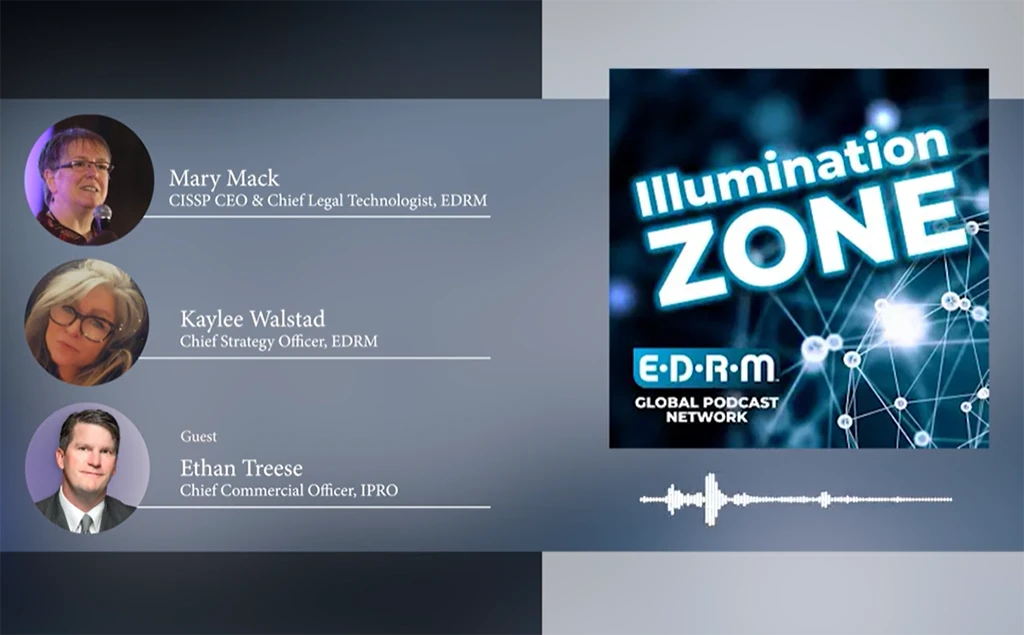
Introduction
Guidelines and frameworks are usually born out of a desire to streamline and perfect processes. But sometimes progress calls for undoing those traditions and entering a new paradigm. Such is the case when it comes to the Electronic Discovery Reference Model (EDRM).
The eDiscovery process itself is always morphing, adapting to new forms and sources of data and new standard practices informed by past experience. For legal counsel and organizations that deal with eDiscovery, this ceaseless change necessitates that they constantly question the status quo and adapt.
In this post, we’ll explore how the EDRM framework is evolving to reflect current eDiscovery approaches. We’ll discuss the origins and stages of the EDRM, explain how the EDRM relates to the Information Governance Reference Model (IGRM), and set out a new approach to eDiscovery that treats it as a non-linear process. Finally, we’ll touch on some of the new and exciting technology you can use to approach the EDRM process more effectively.
Contents
What are the stages of the EDRM?
How does the EDRM relate to the IGRM?
How legal counsel can adapt their approach to the EDRM
How technology can assist legal teams in rethinking their EDRM process
What is EDRM?
The Electronic Discovery Reference Model (EDRM) remains the primary framework for eDiscovery today.
In 2005, eDiscovery experts and consultants George Socha and Tom Gelbmann designed the EDRM to outline a standard approach to the discovery of electronically stored information (ESI).The EDRM refers not only to the framework that Socha and Gelbmann created but also to the organization that was created around it. As an organization, the EDRM is a community of eDiscovery and legal professionals who create practical resources to improve eDiscovery and information governance.
One of the early iterations of the EDRM model is depicted in the above graph. This reflects the original thinking about eDiscovery: that it is a singular, linear, and sequential process. Under this view of eDiscovery, following the steps of the EDRM results in complete eDiscovery.
That isn’t to say that this version of the EDRM contemplated only a forward march that never backtracks or repeats any steps. Rather, the arrows leading from each step down to the bottom line indicate that at any point during the process, an eDiscovery team may have to return to a previous step.
In reality, legal teams should approach eDiscovery and the EDRM as a cyclical process that takes place along multiple continuums at once. This is especially important when the information at hand comes from multiple data sources.
What are the stages of the EDRM?
The EDRM process originally outlined eight stages of eDiscovery: identification, preservation, collection, processing, review, analysis, production, and presentation. Later, the creators of the EDRM added information governance as the first step, resulting in a current total of nine stages.
The EDRM also refers to “volume” on the bottom left of the graph and “relevance” on the bottom right. This indicates that at the beginning of the process, legal counsel will be faced with a high volume of information that has an overall low relevance. Through the eDiscovery process, counsel should strip away irrelevant data, reducing the volume of ESI until they are left with a low volume of data that has a high level of relevance.
Let’s take a more in-depth look at each stage of the EDRM.
1. Information governance
In the EDRM’s view, information governance is an integral part of effective eDiscovery. Information governance, also known as data governance, consists of a set of policies and procedures that organizations use to manage and protect data assets and define who has authority and control over those data assets. Ideally, your organization will employ proper information governance long before the eDiscovery process even begins and continue it long after the matter is resolved. Your organization should also adapt its information governance policies and procedures to reflect any issues that may arise during the eDiscovery process.
2. Identification
Identification is the process by which legal teams search an organization’s data repositories and interview data custodians to identify data sources that may contain relevant information.
3. Preservation
During eDiscovery, an organization must preserve ESI, storing it safely so that it is available for later stages such as processing and review. Preservation is usually accomplished through legal hold notices that advise custodians about the matter and inform them that they must preserve all potentially relevant information. A legal hold also pauses all information governance and records retention protocols that would normally lead the organization to delete or alter data.
4. Collection
Collection involves the use of data-gathering techniques to collect all potentially relevant data and metadata. These techniques must be forensically sound and defensible in case they are challenged by a litigation opponent.
5. Processing
During processing, legal teams use technology to prepare the data they have collected for review and analysis. Data processing dramatically reduces the overall volume of ESI by removing unnecessary system files, duplicates, and irrelevant data. Other processing techniques include concept clustering, which groups data based on shared themes and keywords so data sets are easier to review and analyze.
6. Review
Review—often referred to as document review—is the process by which teams of attorneys evaluate the processed data for responsiveness, attorney-client privilege, work product protection, and other sensitive information. Legal teams then redact and log this information before producing the data. Human review teams tend to work in concert with tools for technology-assisted review or TAR.
7. Analysis
During analysis, legal teams study relevant ESI to identify key patterns, develop case theories, and formulate strategies for discovery, settlement negotiations, and litigation. Note that analysis in particular is not limited to this stage; rather, it should occur throughout the eDiscovery process.
8. Production
Production occurs when the legal team shares all responsive ESI that is not privileged or otherwise protected with the parties who requested it. During this stage, the producing party must follow all agreed-upon discovery protocols, court orders, and rules of procedure.
9. Presentation
Presentation describes the party’s use of data in the courtroom or during other legal proceedings.
But the EDRM isn’t the only framework that relates to the management of discoverable data. There’s also the IGRM, which we’ll turn to next.
How does the EDRM relate to the IGRM?
The EDRM and the Information Governance Reference Model (IGRM) work in tandem to guide organizations in how they manage, recover, and discover ESI.
As noted above, the EDRM has become the primary model for eDiscovery and has expanded to include information governance as one of its nine stages. Since then, the EDRM organization created the IGRM and added it to the EDRM framework to put a greater emphasis on information governance.
The IGRM aims “to frame the discussion of information management, in the same way the [EDRM] functions for eDiscovery.” The IGRM charges five groups with information governance and outlines best practices for those groups to adhere to.
While the EDRM outlines the process for eDiscovery generally and includes information governance as one of its steps, the IGRM dives deeper into that first step to provide a framework for information governance specifically. As such, the IGRM enriches the EDRM by providing more context regarding information governance, a crucial part of proper eDiscovery.
The addition of the IGRM has changed how legal teams think about data—which calls for a new approach to the EDRM too.
How legal counsel should adapt their approach to the EDRM
A new way for legal counsel to approach their EDRM process is by implementing a mini-EDRM framework.
How does this work? Instead of following each EDRM stage as it applies to all data sources, your legal team can isolate each data source and prepare individual eDiscovery workflows for them. That way, you can ensure that your legal team completes each step as it pertains to different data sources while also embracing the non-linearity of the EDRM, making room for new data sources you identify, and allowing for different timelines to run concurrently.
Here’s how to approach the EDRM using a mini-EDRM framework:
- Employ proper information governance (stage 1).
- Identify the data sources that contain relevant information (stage 2).
- Utilize a mini-EDRM framework (stages 3 through 7).
- Create a workflow encompassing stages 3 through 7 for each data source you identified during stage 2.
- Preserve, collect, process, review, and analyze ESI for each data source according to its individual workflow.
- Return to information governance (stage 1) as it pertains to each data source whenever necessary.
- Share all responsive ESI that is not privileged or otherwise protected with the parties who are requesting its production (stage 8).
- Use all relevant data as needed in the courtroom or during other legal proceedings (stage 9).
How technology can assist legal teams in rethinking their EDRM process
Technology can help legal teams reimagine and more effectively complete the EDRM process by improving information governance and streamlining data collection, processing, review, and analysis.
A wide range of eDiscovery tools is currently available that will take you from effective legal holds through the collection, processing, and review stages of the EDRM. Platforms such as OPEN DISCOVERY combine analytics and artificial intelligence (AI) to help your legal team organize ESI, reduce data volume, and search data efficiently to optimize every step of the EDRM process.
In-place search solutions such as Live Early Data Assessment (LIVE EDA] helps legal teams identify and locate relevant data across various sources by performing searches before collection even begins. Live EDA compiles this information into a comprehensive content index that tells you where information lives, why it’s there, how long it’s been there, and who can access and modify it. That index can assist you in the eDiscovery process and give you valuable insights into how your organization can better manage its data going forward.
From that point on, your legal team can collect, process, review, and analyze data more thoroughly and efficiently. You can then add new custodians or data sources to expand your inquiry at any time without having to restart the search process.
These technological solutions can help your organization rethink the EDRM, employing better information governance, gaining valuable insights much earlier on, and improving your overall eDiscovery process. To learn more how modern technology can help you improve your eDiscovery
Overall, by using early case assessment tools, litigation firms will have significantly greater ability in understanding how much data is involved upfront for their clients’ cases and very quickly understand any potential exposure in the initial data set. From there, some firms with the latest technologies in place have been able to speed review by 60 to 90 percent.
Firms will see a positive impact further down the eDiscovery process during review, where more than 70% of document production costs are normally spent. The more insights a Firm gains with early data and case assessment tools, the better the case strategy is likely to be, and the less money and time it will need to spend on getting to that ideal strategy.



